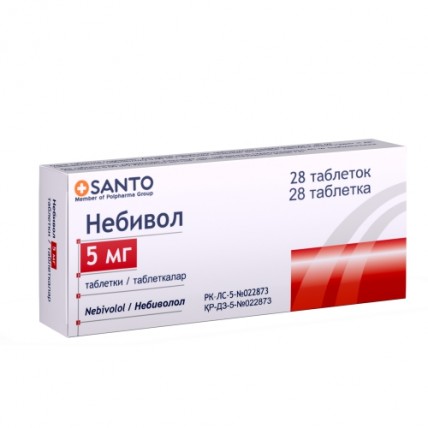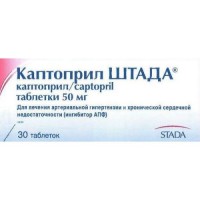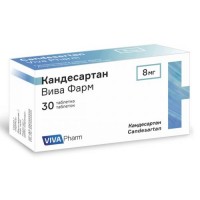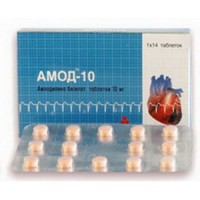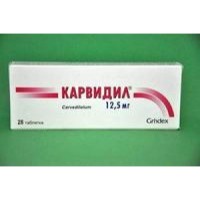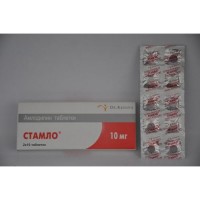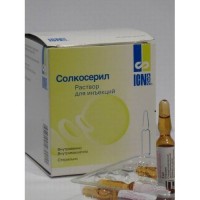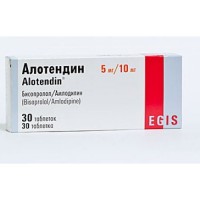Nebivol 5 mg (28 tablets)
- $18.20
The instruction for medical use of Nebivol Torgovoye medicine a name Nebivol Mezhdunarodnoye the unlicensed name Nebivolol Lekarstvennaya a form of a tablet of 5 mg Structure One tablet contains active agent – a nebivolol of a hydrochloride of 5.45 mg (it is equivalent to a nebivolol) (5.00 mg) excipients: lactoses monohydrate, krospovidon type A, half-oxameasures 188, K-30 povidone, cellulose mikroskristallichesky, vivapur, type 102, magnesium stearate, water purified (Is absent in a ready-made product) the Description Round biconvex tablets of white color, with a diameter about 9 mm, with crosswise risky on one party. Pharmacotherapeutic group Beta blockers. Selection beta blockers. Nebivolol. The ATX C07AB12 code the Pharmacological Pharmacokinetics properties Nebivolol is a lipophilic, cardioselective blocker of beta adrenoceptors, it has no internal sympathomimetic activity and membrane stabilizing activity (l-enantiomer). Has also vazodilatiruyushchy effect mediated by nitrogen oxide (d-enantiomer). Absorption After intake happens fast absorption of both enantiomer of a nebivolol. Meal does not influence absorption therefore nebivolol it is possible to accept irrespective of meal. Metabolism Nebivolol is actively metabolized, partially to active hydroxymetabolites. Metabolism of a nebivolol is carried out by alicyclic and aromatic hydroxylation, N-dealkylations and a glyukuronirovaniye, besides, are formed glucuronides of hydroxymetabolites. Metabolism of a nebivolol by aromatic hydroxylation is connected with the genetic oxidizing polymorphism depending on CYP2D6. The bioavailability of a nebivolol at intake averages 12% at persons with fast metabolism and is almost full at persons with slow metabolism. At achievement of an equilibrium state at use of equal doses the maximum concentration of not changed nebivolol in plasma of persons with slow metabolism is about 23 times higher, than at persons with fast metabolism. The maximum concentration in plasma of these two groups of patients taking into account not changed type and active metabolites of drug differ at 1.3-1.4 time. Proceeding from a metabolism speed difference, drug dosing Nebivol should be established always individually for each patient as lower doses can be required for persons with slow metabolism. Besides, the dose has to be corrected for patients aged 65 years, patients with a renal failure and patients with a liver failure are more senior. At persons with fast metabolism the elimination half-life in a phase of elimination of enantiomer of a nebivolol averages 10 hours, and persons with slow metabolism have these values in 3–5 times more. At persons with fast metabolism the concentration of an enantiomer of RSSS in plasma is slightly higher, than concentration of an enantiomer of SRRR. Persons with slow metabolism have this difference more. At persons with fast metabolism the elimination half-life in a phase of elimination of hydroxymetabolites of both enantiomer averages 24 hours, and at persons with slow metabolism it is approximately twice more. The condition of equilibrium concentration in blood plasma for a nebivolol at most of patients (the person with fast metabolism) is reached within 24 hours, and for hydroxymetabolites – in several days. Concentration in blood plasma are proportional to a dose in the range from 1 to 30 mg. The age does not influence pharmacokinetics of a nebivolol. Distribution In blood plasma both enantiomer of a nebivolol are mainly connected with albumine. Linking with proteins of plasma for SRRR небиволола makes 98.1%, and for RSSS небиволола – 97.9%. The volume of distribution is from 10.1 to 39.4 l/kg. Removal In a week after introduction of 38% of a dose is removed with urine and 48% – with a stake. In not changed view with urine no more than 0.5% of the entered dose of a nebivolol are removed. The pharmacodynamics Nebivolol represents the racemate consisting of two enantiomer: SRRR небиволола (or d-nebivolola) and RSSS небиволола (l-nebivolola). Drug combines two pharmacological actions: • Is a competitive and selection blocker of beta adrenoceptors: this effect contacts an enantiomer of SRRR (d-an enantiomer). • Shows soft vazodilatiruyushchy properties owing to metabolic interaction with nitrogen L-argininom/oksidom. At single and repeated use of a nebivolol the heart rate and arterial blood pressure at rest decreases and at loading, it is equal as at persons with normal arterial blood pressure, and at patients with arterial hypertension. The antihypertensive effect at long-term treatment remains. In therapeutic doses the alpha and adrenergic antagonism of a nebivolol is not observed. Equally both at short-term, and at long-term treatment nebivololy at patients with arterial hypertension system vascular resistance decreases. Despite decrease in heart rate, reduction of minute volume of heart at rest and at loading it is limited because of increase in stroke output. The clinical value of this hemodynamic difference, in comparison with that at use of other blockers of beta1-adrenoceptors, is still insufficiently studied. At patients with arterial hypertension nebivolol increases the reaction of vessels to acetylcholine (ACh) mediated by nitrogen oxide, at patients with endothelium dysfunction this reaction is reduced. During placebo - the controlled research directed to assessment of mortality and incidence with participation of 2128 patients aged ³ 70 years (middle age 75.2 years) with stable chronic heart failure with decrease in fraction of emission of a left ventricle or without that (average LVEF: 36 ± 12.3%, with the following distribution: LVEF is lower than 35% at 56% of patients, LVEF to 45% at 25% of patients and LVEF is higher than 45% of 35% at 19% of patients), observed on average within 20 months, use of a nebivolol as addition to standard therapy significantly extended time before a lethal outcome or the hospitalization connected with cardiovascular pathology (primary final point of assessment of efficiency) with relative risk reduction for 14% (absolute decrease in 4.2%). Risk reduction happened after 6 months of therapy and remained during the entire period of treatment (on average 18 months). Action of a nebivolol did not depend on age, sex or an indicator of fraction of emission of a left ventricle of the studied population. Advantage of therapy in relation to risk of the general mortality was statistically not higher in comparison with placebo (absolute decrease: 2.3%). At the patients receiving nebivolol the decrease in frequency of cases of sudden death was noted (4.1% to 6.6%, relative decrease by 38%). In the researches in vitro and in Vivo on animals it is proved what nebivolol has no internal sympathomimetic activity. In the researches in vitro and in Vivo on animals it is proved what nebivolol, applied in pharmacological doses, has no membrane stabilizing effect. In researches with participation of healthy volunteers nebivolol had no significant impact on the maximum tolerance to physical activities or endurance. Indications Arterial hypertension Treatment of essential hypertensia. Chronic heart failure Treatment of stable chronic heart failure of easy and moderate degree, as auxiliary treatment at standard therapy at patients of advanced age (70 years are also more senior). A route of administration and doses the Dosage Arterial hypertension Adults the Dose makes one tablet (5 mg) a day which is better for accepting at the same time every day. The hypotensive effect is shown in 1–2 weeks of treatment. In rare instances the optimum effect of drug develops only in 4 weeks of reception. Use in a combination with other antihypertensive medicines Beta blockers can be applied in monotherapy or in a combination with other antihypertensive drugs. Today the additive antihypertensive effect was observed only at simultaneous use of the drug Nebivol and a hydrochlorothiazide in a dose of 12.5-25 mg. Patients with a renal failure the Recommended initial dose for patients with a renal failure makes 2.5 mg a day. If necessary it is possible to increase a daily dose to 5 mg. Patients with a liver failure the Experience of use of drug for patients with a liver failure or abnormal liver functions is limited. Therefore use of the drug Nebivol for such patients is contraindicated. Patients of advanced age For patients are aged more senior than 65 years the recommended initial dose makes 2.5 mg a day. If necessary it is possible to increase a daily dose to 5 mg. At the same time, considering limited experience of use of drug for patients 75 years aged are more senior, it is necessary to be careful and to watch carefully such patients. Children and teenagers of the Research at children and teenagers were not carried out. Therefore it is not recommended to appoint drug in this group of patients. Chronic heart failure Treatment of stable chronic heart failure has to begin with gradual titration of a dose before achievement of an individual optimum maintenance dose. To patients appoint drug if chronic heart failure without episodes of its sharp decompensation within the last 6 weeks takes place. The attending physician has to have experience of treatment of chronic heart failure. The patients receiving other cardiovascular medicines, including diuretics and (or) digoxin and (or) APF inhibitors and (or) antagonists of receptors of angiotensin II, have to accept already picked up dose of these drugs within 2 weeks preceding an initiation of treatment the drug Nebivol. It is necessary to increase an initial dose each 1-2 weeks, depending on tolerance of drug the patient: 1.25 mg of a nebivolol increase up to 2.5 mg of a nebivolol once a day, then up to 5 mg up to 10 mg once a day and further once a day. The maximum recommended dose makes 10 mg of a nebivolol once a day. And at each increase in a dose the patient has to be in an initiation of treatment not less than 2 hours under observation of the experienced doctor to be convinced that the clinical condition of the patient remains stable (especially it concerns the level of arterial blood pressure, heart rate, disturbance of conductivity of a myocardium, strengthening of symptoms of heart failure). Development of side reactions can make impossible use of the maximum recommended drug dose. If necessary the maintenance dose can be lowered also gradually and again to increase if there are indications. When strengthening symptoms of heart failure or at intolerance of drug in a phase of its titration first of all it is recommended to lower a dose of a nebivolol or, in case of need, immediately to interrupt treatment (at appearance of heavy arterial hypotension, strengthening of symptoms of heart failure with an acute fluid lungs, at development of cardiogenic shock, symptomatic bradycardia or atrioventricular block). As a rule, therapy of stable chronic heart failure using a nebivolol is long. It is not recommended to stop sharply use of a nebivolol as it can lead to tranzitorny strengthening of symptoms of heart failure. If drug needs to be cancelled, the dose should be reduced step by step, reducing it half within every week. Patients As titration of a dose to the most transferable patient happens to a renal failure gradually, its correction in a renal failure easy and moderate severity is not required. There is no experience of use of drug for patients with a heavy renal failure (level of creatinine of blood serum of ≥250 µmol/l) therefore purpose of a nebivolol is not recommended to such patients. Patients with a liver failure the Data concerning patients with a liver failure are limited. Therefore use of the drug Nebivol for these patients is contraindicated. Patients of advanced age As titration of a dose to the most transferable patient of a dose is carried out gradually, dose adjustment is not required. Children and teenagers of the Research at children and teenagers were not carried out. Therefore it is not recommended to appoint drug in this group of patients. The route of administration the Tablet or its part should be swallowed, washing down with enough liquid (for example, a glass of water). A pill can be taken irrespective of meal. Side effects the Side reactions developing at treatment of arterial hypertension and chronic heart failure are specified separately, in connection with distinctions during basic diseases. Arterial hypertension the Registered side reactions which in most cases had severity from easy to moderated are grouped in the table below according to classification by the main systems and bodies and by emergence frequency: Often (≥1/100 to & lt, 1/10) - a headache, dizziness - paresthesia - short wind - a constipation, nausea, diarrhea - increased fatigue - hypostases Infrequently (≥1/1000 to & lt, 1/100) - dreadful dreams, a depression - a disorder of vision - bradycardia, heart failure, delay of atrioventricular conductivity / atrioventricular block - arterial hypotension, the alternating lameness (or its aggravation) - a bronchospasm - dyspepsia, a meteorism, vomiting - an itching, erythematic rash - impotence Very seldom (& lt, 1/10000) - a syncope - Does not know exacerbation of psoriasis (on the basis of available data it is impossible to determine frequency) - a Quincke's disease, hypersensitivity, a small tortoiseshell Besides, at use of some blockers of beta adrenoceptors was reported about the following side reactions: hallucinations, psychoses, confusion of consciousness, cold snap/cyanosis of extremities, Reynaud's syndrome, xerophthalmus and okulo-mukokutanny toxicity on praktololovy type. Chronic heart failure there Are data, the concerning developments of adverse side reactions in patients with chronic heart failure gained in one placebo - controlled clinical trial with participation of 1067 patients receiving nebivolol and 1061 patient receiving placebo. In this research about side reactions which communication with treatment was estimated as possible, reported in total 449 patients receiving nebivolol (42.1%), in comparison with 334 patients receiving placebo (31.5%). Bradycardia and dizzinesses were the most frequent side reactions about which the patients accepting nebivolol reported, both arose approximately at 11% of patients. Frequency of their development in the patients receiving placebo was about 2% and 7% respectively. The following frequency of development of side reactions (which communication with drug is estimated, at least, as possible), which are considered directly connected with treatment of chronic heart failure is established: - Strengthening of symptoms of heart failure happened at 5.8% of the patients receiving nebivolol in comparison with 5.2% of the patients receiving placebo. - Orthostatic arterial hypotension is noted at 2.1% of the patients receiving nebivolol in comparison with 1.0% of the patients receiving placebo. - The intolerance of drug arose at 1.6% of the patients receiving nebivolol in comparison with 0.8% of the patients receiving placebo. - Atrioventricular block of 1 degree developed at 1.4% of the patients receiving nebivolol in comparison with 0.9% of the patients receiving placebo. - Hypostases of the lower extremities are noted at 1.0% of the patients receiving nebivolol in comparison with 0.2% of the patients receiving placebo. Contraindications - hypersensitivity to active agent or drug excipients - a liver failure or an abnormal liver function - the acute heart failure, cardiogenic shock or episodes of a decompensation of heart failure demanding intravenous administration of medicines with positive inotropic effect. Like other beta blockers, the drug Nebivol is also contraindicated at: - a syndrome of weakness of a sinus node, including sinoauricular block - atrioventricular the block
e the second and third degree (without artificial pacemaker) - a bronchospasm and bronchial asthma in the anamnesis - not treated pheochromocytoma - a metabolic acidosis - not treated pheochromocytoma - bradycardia (heart rate & lt, 60 reductions in a minute prior to treatment) - arterial hypotension (systolic arterial blood pressure of blood & lt, 90 mm Hg.) - serious violations of peripheric circulation. - children's and teenage age up to 18 years - the lactation period Medicinal interactions Pharmakodinamichesky interactions the forms of interaction Described below concern all blockers of beta adrenoceptors. Simultaneous use with the following drugs is not recommended: Antiarrhytmic drugs I of a class (quinidine, hydroquinidine, tsibenzolin, flekainid, Disopyramidum, lidocaine, meksiletin, propafenon): the atrioventricular conductivity can amplify and increase negative isotropic effect. Antagonists of calcium ions of type of verapamil / diltiazema: negative impact on contractility of a myocardium and atrioventricular conductivity. Intravenous administration of verapamil to patients who receive beta blockers can lead to the profound arterial hypotension and atrioventricular block. Antihypertensive drugs of the central action (clonidine, guanfatsin, moksonidin, Methyldopum, rilmenidin): simultaneous use of antihypertensive drugs of the central action can worsen symptoms of heart failure owing to decrease in the central sympathomimetic tone (decrease in heart rate and warm emission, a vazodilatation). Sudden drug withdrawal, especially before beta blocker phase-out, can increase risk of developing of "ricochet arterial hypertension". Drugs which need to be applied with the increased care: Antiarrhytmic drugs III of a class (Amiodaronum): strengthening of influence on atrioventricular conductivity is possible. The general anesthetics – galogensoderzhashchy inhalation means: the combined use of beta blockers with the general anesthetics can reduce reflex tachycardia and increase risk of developing of arterial hypotension. It is necessary to be guided by the general rule to avoid the sudden termination of intake of beta blockers. It is necessary to inform the anesthesiologist on intake of the drug Nebivol by the patient. Insulin and oral hypoglycemic drugs: in spite of the fact that nebivolol does not influence glucose level, simultaneous use can mask hypoglycemia symptoms (the strengthened heartbeat, tachycardia). Baclofenum (muscle relaxant), amifostin (auxiliary antineoplastic drug): simultaneous use with antihypertensive drugs probably enhances effect of a lowering of arterial pressure of blood, considering it, the dose of antihypertensive drugs is as appropriate adjusted. The combined treatment demanding expediency assessment: Cardiac glycosides: simultaneous use of drugs can cause delay of atrioventricular conductivity. Clinical trials of a nebivolol did not reveal clinical proofs of interaction. Nebivolol does not influence digoxin pharmacokinetics. Antagonists of calcium ions of dihydropyridinic type (amlodipin, felodipin, latsidipin, nifedipine, nikardipin, nimodipin, nitrendipin): simultaneous use of such drugs can increase risk of developing arterial hypotension, it is impossible to exclude also increased risk of further deterioration in function of ventricles at patients with heart failure. Antipsychotic drugs, antidepressants (tricyclic antidepressants, barbiturates and derivatives of a fenotiazin), organic nitrates and also other antihypertensive drugs: at simultaneous use the hypotensive effect of beta blockers (additive effect) can amplify. Non-steroidal anti-inflammatory drugs (NPVP): do not influence hypotensive action of a nebivolol. Sympathomimetics: at the combined use can reduce activity of blockers of beta adrenoceptors. Beta blockers can result in free alpha and adrenergic activity of sympathomimetics, as with alpha and adrenergic, and beta and adrenergic action (risk of developing arterial hypertension, heavy bradycardia and heart block). Pharmacokinetic interactions As CYP2D6 isoenzyme, the combined use of inhibitors of this enzyme, especially such as paroksetin, fluoxetine, thioridazine and quinidine, can lead to increase in level of a nebivolol in blood plasma that is connected with increase in risk of developing bradycardia and side effects takes part in metabolism of a nebivolol. Simultaneous use of Cimetidinum increases the level of a nebivolol in blood plasma without change of clinical effects. Simultaneous use of ranitidine does not influence pharmacokinetics of a nebivolol. Nebivolol it is possible to apply together with antiacid medicines provided that Nebivol accept at meal time, and antiacid medicines - between meals. At the combined use of a nebivolol and nikardipin the concentration of both drugs in blood plasma without change of their clinical performance slightly increases. Simultaneous alcohol intake, use of furosemide or a hydrochlorothiazide does not influence pharmacokinetics of a nebivolol. Nebivolol does not influence pharmacokinetics and a pharmacodynamics of warfarin. Special instructions the preventions Described below and precautionary measures concern all blockers of beta adrenoceptors. The general anesthesia Maintenance of blockade of beta adrenoceptors reduces risk of disturbances of a warm rhythm during introduction to an anesthesia and intubations. If blockade of beta adrenoceptors is interrupted for the purpose of training of the patient for surgical intervention, it is necessary to cancel administration of beta blockers not less than in 24 hours prior to operation. It is necessary to be careful at use of the separate anesthetics causing oppression of function of a myocardium. Emergence of vagal reactions in the patient can be prevented by means of intravenous administration of atropine. A cardiovascular system Patients with not treated stagnant heart failure should not appoint beta blockers before stabilization of their state. It is necessary to stop therapy by beta blockers at patients with coronary heart disease gradually, i.e. within more than 1–2 weeks. If necessary, to prevent exacerbation of stenocardia, it is recommended to begin replacement therapy at the same time. Beta blockers can cause bradycardia: if pulse at rest decreases to 50–55 beats per minute and (or) at the patient the symptoms indicating bradycardia develop, the dose needs to be lowered. Beta blockers should be applied with care at treatment: · patients with disturbances of peripheric circulation (disease or Reynaud's syndrome, the alternating lameness) as exacerbation of the specified diseases can develop, · patients with atrioventricular block of the I degree in connection with delay by beta blockers of warm conductivity, · patients with Printsmetal's stenocardia in connection with risk free, mediated through alpha adrenoceptors, vasoconstrictions of coronary arteries: beta blockers can increase the frequency and duration of attacks of stenocardia. Usually it is not recommended to apply nebivolol along with antagonists of calcium of type of verapamil and a diltiazepam, with antiarrhytmic drugs I of a class and antihypertensive drugs of the central action. Exchange of substances / the endocrine Nebivol system does not influence glucose content in blood at patients with diabetes. However at such patients drug should be used with care as nebivolol can mask some signs of a hypoglycemia (tachycardia, the strengthened heartbeat). Beta blockers can mask tachycardia symptoms at hyperfunction of a thyroid gland. At sudden drug withdrawal these symptoms can amplify. A respiratory system Patients with chronic obstructive pulmonary diseases should apply beta blockers with care, in view of the possible strengthening of a konstriktion of airways caused by these drugs. Other Appoint Beta Blockers systems it is possible for patients with psoriasis in the anamnesis only after comparison of risk and advantage of administration of drug. Beta blockers can increase sensitivity to allergens and severity of anaphylactic reactions. It is necessary to begin treatment of chronic heart failure under constant observation. The mode of dosing and a route of administration are described in the section "Route of Administration and Doses". It is not necessary to interrupt suddenly treatment, except emergency cases. The drug Nebivol contains lactose therefore patients should not appoint it with rare hereditary intolerance of a galactose, deficiency of lactase (Lappa type) or a sprue of glucose galactose. Pregnancy and the period of a lactation Pharmacological action of a nebivolol can have negative impact on a course of pregnancy and (or) on the fruit/newborn. Beta blockers reduce a blood stream in a placenta that can lead to a growth inhibition, intrauterine death of a fruit, a misbirth or premature births. At a fruit and the newborn side reactions can develop (for example, a hypoglycemia and bradycardia). If treatment by beta blockers is necessary, it is recommended to apply the medicines selectively blocking beta1-adrenergichesky receptors. The drug Nebivol should not be used during pregnancy without emergency. If treatment nebivololy is necessary, it is necessary to make observation of uteroplacental blood circulation and fetation. In case of negative impact on a course of pregnancy or fetation, it is necessary to consider a question of treatment by alternative drugs. It is necessary to watch the newborn carefully. Symptoms of a hypoglycemia and bradycardia can develop during the first three days. Researches on animals showed what nebivolol is allocated with breast milk. It is not known whether drug with breast milk of women is emitted. The majority of beta blockers, especially lipophilic connections, such as nebivolol and its active metabolites, are allocated with breast milk, though in various quantities. Therefore at drug Nebivol use the breastfeeding is not recommended. Features of influence of medicine on ability to run the vehicle or potentially dangerous mechanisms of the Research, the concerning influences on ability to control of vehicles and to service of mechanisms, were not carried out. Pharmakodinamichesky researches showed that Nebivol does not influence psychomotor function. At control of vehicles or service of mechanisms it is necessary to consider that administration of drug can sometimes cause dizziness and feeling of fatigue. Overdose the Data concerning drug Nebivol overdose no. Symptoms overdose Symptoms beta blockers are: bradycardia, arterial hypotension, bronchospasm and acute heart failure. Treatment in case of overdose or reaction of hypersensitivity the patient has to be under careful observation and undergo treatment in intensive care unit. It is necessary to control glucose level in blood. Absorption of the drug which is in digestive tract can be prevented by gastric lavage and administration of activated carbon and depletive. Carrying out artificial ventilation of the lungs can be necessary. In bradycardia and the raised vagotonia it is necessary to enter atropine or methylatropine. In case of arterial hypotension and shock it is necessary to enter plasma or plasma substitutes, if necessary enter catecholamines. Beta and adrenoceptor blocking action can be stopped slow intravenous administration of an izoprenalin of a hydrochloride, since a dose about 5 mkg/min., or Dobutaminum, since a dose of 2.5 mkg/min. before achievement of the expected effect. In the absence of treatment response it is possible to enter izoprenalin along with a dopamine. In case the above-stated methods are inefficient, it is necessary to consider expediency of intravenous administration of a glucagon in a dose of 50-100 mkg/kg. If it is necessary, the injection can be repeated within an hour and, if necessary, to carry out intravenous infusion of a glucagon at the rate of 70 mkg/kg/h. In extreme cases in the bradycardia which is not responding to pharmacological treatment the connection of an artificial pacemaker can be required. The form of release and packing On 7 or 14 tablets place in blister strip packaging from a film of polyvinylchloride and aluminum foil. On 1 (on 14 tablets), 2 (on 7 or 14 tablets) or 4 (on 7 tablets) blister strip packagings together with the instruction for medical use in the state and Russian languages place in a pack from cardboard. To Store storage conditions at a temperature not above 25 °C. To store out of children's reach! 3 years not to use a period of storage after an expiration date. Prescription status According to the prescription the Producer/packer S.A. Spetsifar, Athens, Greece the Owner of the registration certificate of JSC Khimfarm, Shymkent, the Republic of Kazakhstan
to Develop the Address of the organization accepting in the territory of the Republic of Kazakhstan claims from consumers on quality of products of JSC Khimfarm, Republic of Kazakhstan, Shymkent, Rashidov St., 81 the Address of the organization in the territory of the Republic of Kazakhstan responsible for post-registration observation of safety of medicine of JSC Khimfarm Republic of Kazakhstan, Shymkent, Rashidov St., 81
e the second and third degree (without artificial pacemaker) - a bronchospasm and bronchial asthma in the anamnesis - not treated pheochromocytoma - a metabolic acidosis - not treated pheochromocytoma - bradycardia (heart rate & lt, 60 reductions in a minute prior to treatment) - arterial hypotension (systolic arterial blood pressure of blood & lt, 90 mm Hg.) - serious violations of peripheric circulation. - children's and teenage age up to 18 years - the lactation period Medicinal interactions Pharmakodinamichesky interactions the forms of interaction Described below concern all blockers of beta adrenoceptors. Simultaneous use with the following drugs is not recommended: Antiarrhytmic drugs I of a class (quinidine, hydroquinidine, tsibenzolin, flekainid, Disopyramidum, lidocaine, meksiletin, propafenon): the atrioventricular conductivity can amplify and increase negative isotropic effect. Antagonists of calcium ions of type of verapamil / diltiazema: negative impact on contractility of a myocardium and atrioventricular conductivity. Intravenous administration of verapamil to patients who receive beta blockers can lead to the profound arterial hypotension and atrioventricular block. Antihypertensive drugs of the central action (clonidine, guanfatsin, moksonidin, Methyldopum, rilmenidin): simultaneous use of antihypertensive drugs of the central action can worsen symptoms of heart failure owing to decrease in the central sympathomimetic tone (decrease in heart rate and warm emission, a vazodilatation). Sudden drug withdrawal, especially before beta blocker phase-out, can increase risk of developing of "ricochet arterial hypertension". Drugs which need to be applied with the increased care: Antiarrhytmic drugs III of a class (Amiodaronum): strengthening of influence on atrioventricular conductivity is possible. The general anesthetics – galogensoderzhashchy inhalation means: the combined use of beta blockers with the general anesthetics can reduce reflex tachycardia and increase risk of developing of arterial hypotension. It is necessary to be guided by the general rule to avoid the sudden termination of intake of beta blockers. It is necessary to inform the anesthesiologist on intake of the drug Nebivol by the patient. Insulin and oral hypoglycemic drugs: in spite of the fact that nebivolol does not influence glucose level, simultaneous use can mask hypoglycemia symptoms (the strengthened heartbeat, tachycardia). Baclofenum (muscle relaxant), amifostin (auxiliary antineoplastic drug): simultaneous use with antihypertensive drugs probably enhances effect of a lowering of arterial pressure of blood, considering it, the dose of antihypertensive drugs is as appropriate adjusted. The combined treatment demanding expediency assessment: Cardiac glycosides: simultaneous use of drugs can cause delay of atrioventricular conductivity. Clinical trials of a nebivolol did not reveal clinical proofs of interaction. Nebivolol does not influence digoxin pharmacokinetics. Antagonists of calcium ions of dihydropyridinic type (amlodipin, felodipin, latsidipin, nifedipine, nikardipin, nimodipin, nitrendipin): simultaneous use of such drugs can increase risk of developing arterial hypotension, it is impossible to exclude also increased risk of further deterioration in function of ventricles at patients with heart failure. Antipsychotic drugs, antidepressants (tricyclic antidepressants, barbiturates and derivatives of a fenotiazin), organic nitrates and also other antihypertensive drugs: at simultaneous use the hypotensive effect of beta blockers (additive effect) can amplify. Non-steroidal anti-inflammatory drugs (NPVP): do not influence hypotensive action of a nebivolol. Sympathomimetics: at the combined use can reduce activity of blockers of beta adrenoceptors. Beta blockers can result in free alpha and adrenergic activity of sympathomimetics, as with alpha and adrenergic, and beta and adrenergic action (risk of developing arterial hypertension, heavy bradycardia and heart block). Pharmacokinetic interactions As CYP2D6 isoenzyme, the combined use of inhibitors of this enzyme, especially such as paroksetin, fluoxetine, thioridazine and quinidine, can lead to increase in level of a nebivolol in blood plasma that is connected with increase in risk of developing bradycardia and side effects takes part in metabolism of a nebivolol. Simultaneous use of Cimetidinum increases the level of a nebivolol in blood plasma without change of clinical effects. Simultaneous use of ranitidine does not influence pharmacokinetics of a nebivolol. Nebivolol it is possible to apply together with antiacid medicines provided that Nebivol accept at meal time, and antiacid medicines - between meals. At the combined use of a nebivolol and nikardipin the concentration of both drugs in blood plasma without change of their clinical performance slightly increases. Simultaneous alcohol intake, use of furosemide or a hydrochlorothiazide does not influence pharmacokinetics of a nebivolol. Nebivolol does not influence pharmacokinetics and a pharmacodynamics of warfarin. Special instructions the preventions Described below and precautionary measures concern all blockers of beta adrenoceptors. The general anesthesia Maintenance of blockade of beta adrenoceptors reduces risk of disturbances of a warm rhythm during introduction to an anesthesia and intubations. If blockade of beta adrenoceptors is interrupted for the purpose of training of the patient for surgical intervention, it is necessary to cancel administration of beta blockers not less than in 24 hours prior to operation. It is necessary to be careful at use of the separate anesthetics causing oppression of function of a myocardium. Emergence of vagal reactions in the patient can be prevented by means of intravenous administration of atropine. A cardiovascular system Patients with not treated stagnant heart failure should not appoint beta blockers before stabilization of their state. It is necessary to stop therapy by beta blockers at patients with coronary heart disease gradually, i.e. within more than 1–2 weeks. If necessary, to prevent exacerbation of stenocardia, it is recommended to begin replacement therapy at the same time. Beta blockers can cause bradycardia: if pulse at rest decreases to 50–55 beats per minute and (or) at the patient the symptoms indicating bradycardia develop, the dose needs to be lowered. Beta blockers should be applied with care at treatment: · patients with disturbances of peripheric circulation (disease or Reynaud's syndrome, the alternating lameness) as exacerbation of the specified diseases can develop, · patients with atrioventricular block of the I degree in connection with delay by beta blockers of warm conductivity, · patients with Printsmetal's stenocardia in connection with risk free, mediated through alpha adrenoceptors, vasoconstrictions of coronary arteries: beta blockers can increase the frequency and duration of attacks of stenocardia. Usually it is not recommended to apply nebivolol along with antagonists of calcium of type of verapamil and a diltiazepam, with antiarrhytmic drugs I of a class and antihypertensive drugs of the central action. Exchange of substances / the endocrine Nebivol system does not influence glucose content in blood at patients with diabetes. However at such patients drug should be used with care as nebivolol can mask some signs of a hypoglycemia (tachycardia, the strengthened heartbeat). Beta blockers can mask tachycardia symptoms at hyperfunction of a thyroid gland. At sudden drug withdrawal these symptoms can amplify. A respiratory system Patients with chronic obstructive pulmonary diseases should apply beta blockers with care, in view of the possible strengthening of a konstriktion of airways caused by these drugs. Other Appoint Beta Blockers systems it is possible for patients with psoriasis in the anamnesis only after comparison of risk and advantage of administration of drug. Beta blockers can increase sensitivity to allergens and severity of anaphylactic reactions. It is necessary to begin treatment of chronic heart failure under constant observation. The mode of dosing and a route of administration are described in the section "Route of Administration and Doses". It is not necessary to interrupt suddenly treatment, except emergency cases. The drug Nebivol contains lactose therefore patients should not appoint it with rare hereditary intolerance of a galactose, deficiency of lactase (Lappa type) or a sprue of glucose galactose. Pregnancy and the period of a lactation Pharmacological action of a nebivolol can have negative impact on a course of pregnancy and (or) on the fruit/newborn. Beta blockers reduce a blood stream in a placenta that can lead to a growth inhibition, intrauterine death of a fruit, a misbirth or premature births. At a fruit and the newborn side reactions can develop (for example, a hypoglycemia and bradycardia). If treatment by beta blockers is necessary, it is recommended to apply the medicines selectively blocking beta1-adrenergichesky receptors. The drug Nebivol should not be used during pregnancy without emergency. If treatment nebivololy is necessary, it is necessary to make observation of uteroplacental blood circulation and fetation. In case of negative impact on a course of pregnancy or fetation, it is necessary to consider a question of treatment by alternative drugs. It is necessary to watch the newborn carefully. Symptoms of a hypoglycemia and bradycardia can develop during the first three days. Researches on animals showed what nebivolol is allocated with breast milk. It is not known whether drug with breast milk of women is emitted. The majority of beta blockers, especially lipophilic connections, such as nebivolol and its active metabolites, are allocated with breast milk, though in various quantities. Therefore at drug Nebivol use the breastfeeding is not recommended. Features of influence of medicine on ability to run the vehicle or potentially dangerous mechanisms of the Research, the concerning influences on ability to control of vehicles and to service of mechanisms, were not carried out. Pharmakodinamichesky researches showed that Nebivol does not influence psychomotor function. At control of vehicles or service of mechanisms it is necessary to consider that administration of drug can sometimes cause dizziness and feeling of fatigue. Overdose the Data concerning drug Nebivol overdose no. Symptoms overdose Symptoms beta blockers are: bradycardia, arterial hypotension, bronchospasm and acute heart failure. Treatment in case of overdose or reaction of hypersensitivity the patient has to be under careful observation and undergo treatment in intensive care unit. It is necessary to control glucose level in blood. Absorption of the drug which is in digestive tract can be prevented by gastric lavage and administration of activated carbon and depletive. Carrying out artificial ventilation of the lungs can be necessary. In bradycardia and the raised vagotonia it is necessary to enter atropine or methylatropine. In case of arterial hypotension and shock it is necessary to enter plasma or plasma substitutes, if necessary enter catecholamines. Beta and adrenoceptor blocking action can be stopped slow intravenous administration of an izoprenalin of a hydrochloride, since a dose about 5 mkg/min., or Dobutaminum, since a dose of 2.5 mkg/min. before achievement of the expected effect. In the absence of treatment response it is possible to enter izoprenalin along with a dopamine. In case the above-stated methods are inefficient, it is necessary to consider expediency of intravenous administration of a glucagon in a dose of 50-100 mkg/kg. If it is necessary, the injection can be repeated within an hour and, if necessary, to carry out intravenous infusion of a glucagon at the rate of 70 mkg/kg/h. In extreme cases in the bradycardia which is not responding to pharmacological treatment the connection of an artificial pacemaker can be required. The form of release and packing On 7 or 14 tablets place in blister strip packaging from a film of polyvinylchloride and aluminum foil. On 1 (on 14 tablets), 2 (on 7 or 14 tablets) or 4 (on 7 tablets) blister strip packagings together with the instruction for medical use in the state and Russian languages place in a pack from cardboard. To Store storage conditions at a temperature not above 25 °C. To store out of children's reach! 3 years not to use a period of storage after an expiration date. Prescription status According to the prescription the Producer/packer S.A. Spetsifar, Athens, Greece the Owner of the registration certificate of JSC Khimfarm, Shymkent, the Republic of Kazakhstan
to Develop the Address of the organization accepting in the territory of the Republic of Kazakhstan claims from consumers on quality of products of JSC Khimfarm, Republic of Kazakhstan, Shymkent, Rashidov St., 81 the Address of the organization in the territory of the Republic of Kazakhstan responsible for post-registration observation of safety of medicine of JSC Khimfarm Republic of Kazakhstan, Shymkent, Rashidov St., 81
